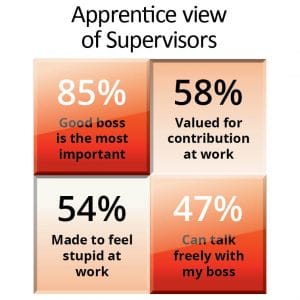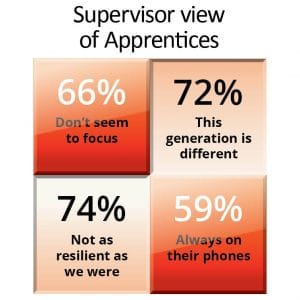Communication is key
More than 50 percent of automotive apprentices don’t finish


Research has found communication breakdown as the number one reason for apprentice drop-outs. It’s not necessarily about having the most modern workshop or the best wages. Research also found that those supervisors who saw this generation of apprentices as the same as any other generation had fewer issues with drop-outs.
The Australian Chamber of Commerce and Industry commissioned VACC to undertake research into improving apprentice retention in the automotive industry. This research has identified six problem areas in apprentice-supervisor communication.
VACC created 10 short videos to help supervisors and apprentices improve communication and address these problem areas. Supervisors and apprentices report these strategies have made a significant improvement in communication.
These videos include communication problem scenarios and case studies of small and large automotive businesses who have good relations between apprentices and bosses.
Improve communication in your workplace
Supervisors and apprentices feel more comfortable and are more productive with better communication in the workplace. Taking on an apprentice is no small commitment, and losing an apprentice is difficult for everyone involved. Good communication means issues can be raised and addressed before they become a significant problem.
Employers, supervisors, apprentices and trainers in the industry identified six main areas of communication breakdown between supervisors and apprentices in the workshop.
The videos demonstrate a positive solution in each situation. Each video is linked to a page with suggestions on how to use it in your workplace and a poster which can be printed off and filled out at a toolbox meeting.
CASE STUDIES
Two large and two small automotive businesses demonstrate the benefits of a positive workplace culture and strong communication between all staff, including apprentices. Each gives an insight into how they have addressed the six identified problem areas.
Hallam Truck Centre
Hallam Truck Centre’s apprenticeship program focuses on developing a culture based on strong communication and understanding between the supervisor and the apprentice. This has resulted in improved apprentice retention rates since the program’s inception.
William Adams
William Adams focuses on two-way communication not only between apprentices and supervisors, but also between apprentices and upper levels of management. Developing these strong working relationships helps apprentices feel that they are an integral part of the business.
Turbo Engineering
Turbo Engineering promotes a collaborative learning culture in its workplace and employs a flexible phone policy that understands the positive role that phone technology can have towards learning. Apprentices also play a role in the company’s customer service. Supervisors ensure apprentices keep learning new skills at work.
Rob’s Auto Elec’s
Rob’s Auto Elec’s fosters a workplace culture that focuses on apprenticeships as a learning process. The company’s approach to teaching is to provide a learning process that adapts to the apprentice’s learning style, whether it’s academic or hands-on. Supervisors focus on setting a standard for apprentices to follow.
Feedback from industry
Apprentices, supervisors and trainers who took part in this project have responded positively. Surveys found communications in the six identified problem areas improved by seven to 13 per cent. Find out more.
Apprentices and supervisors shared their thoughts:
- “I will be showing all our employees the videos. All the messages have value for all employees.”
- “Sometimes the qualified guys can forget how the obvious for them is not so obvious for the new apprentice.”
- “I will include the video in the induction package for new apprentices.”
- “I know if I have an appointment in work hours to give plenty of notice so the managers know that I will be absent for the given times.”
If you wish to make a comment about the Apprentice Communication and Retention Project, please send us an email.

The Productivity Leadership Program has been established by Australian Chamber of Commerce and Industry (ACCI) with the assistance of funding provided by the Department of Employment.






